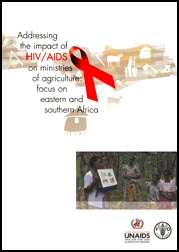 by Daphne Topouzis, Ph.D.
by Daphne Topouzis, Ph.D.  by Daphne Topouzis, Ph.D.
by Daphne Topouzis, Ph.D. A Joint FAO/UNAIDS Publication
Rome, 2003
|
The designations employed and the presentation of material in this information product do not imply the expression of any opinion whatsoever on the part of the Food and Agriculture Organization of the United Nations concerning the legal status of any country, territory, city or area or of its authorities, or concerning the delimitation of its frontiers or boundaries. |
All rights reserved. Reproduction and dissemination of material in this information product for educational or other non-commercial purposes are authorized without any prior written permission from the copyright holders provided the source is fully acknowledged. Reproduction of material in this information product for resale or other commercial purposes is prohibited without written permission of the copyright holders. Applications for such permission should be addressed to the Chief, Publishing Management Service, Information Division, FAO, Viale delle Terme di Caracalla, 00100 Rome, Italy or by e-mail to [email protected]
© FAO 2003
2. THE IMPACT OF HIV/AIDS ON THE AGRICULTURAL SECTOR
3. THE RELEVANCE OF HIV/AIDS FOR MoAs
3.1 MoA staff vulnerability to HIV infection and AIDS impact
3.1.1 MoA staff knowledge and awareness of HIV/AIDS
3.1.2 Attitudes toward HIV/AIDS within MoAs: stigmatisation and discrimination
3.1.3 MoA staff exposed to high risk situations
3.1.4 Response Measures3.2 Disruption of MoA operations and erosion of capacity
3.2.1 The determinants of HIV/AIDS impact
a) Reduced staff productivity
b) Increase in Ministerial expenditures
c) Increase in staff turnover
d) Increase in the workload of MoA staff
e) Loss of knowledge, skills and experiencea) Human capacity development
b) Mainstreaming HIV/AIDS in the work of MoAs
c) Adjusting MoA budgets3.3 Increased vulnerability of MoA clients to food and livelihood insecurity
3.3.1 The impact of HIV/AIDS on food and livelihood security
a) Adverse effects on land/labour productivity and on agricultural production
b) Decline in on- and off-farm disposable household income
c) Erosion of farm household resource and asset base
d) Erosion of knowledge base and skills for agricultural productiona) The introduction of labour- and capital-saving agricultural and household technologies and practices
b) The enhancement of household income-generating capacity
c) The promotion of women's and children's rights to land and other property
d) Apprenticeship schemes and agricultural skills training for adolescents3.4 Are MoA policies, strategies and programmes still relevant?
3.4.1 The implications of HIV/AIDS for MoA policies, strategies and programmes
a) The limitations of a production-oriented approach
b) Farm household labour: an abundant resource?
c) Changing farm household typologies
4. CREATING CAPACITY FOR AN MoA RESPONSE TO HIV/AIDS
4.1 Addressing the impact of HIV/AIDS within MoAs
4.2 Adjusting MoA policies, programmes and services